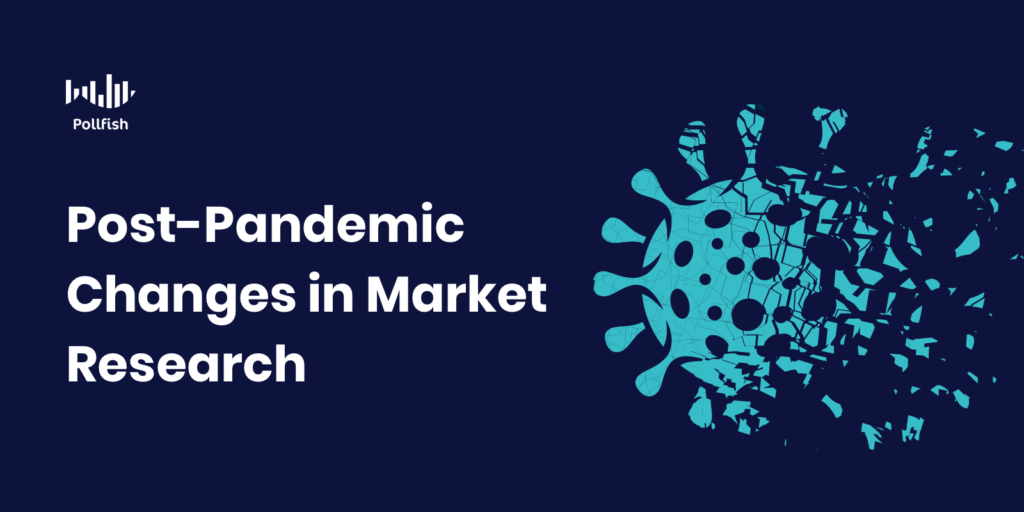Acclimating to Market Research in a Post-Pandemic World

The COVID-19 pandemic has upturned the world in many ways, including the world of market research. However, the post-pandemic world has been gradually emerging, with mass vaccine rollouts, reopenings, office returns for certain workers and the lift of various pandemic-related restrictions.
There are still many market changes that market research constantly seeks to better understand, such as customer expectations, customer behavior, expenditures, loyalty and all other consumer-related factors.
One such change involves customer shopping behavior; three-quarters of Americans changed their shopping behaviors since the pandemic began, with 40% of customers switching brands. The percentage of brand-switching is double that of 2019, showing that customer loyalty is not permanent and many customers will patronize new businesses, should those businesses meet their demands more effectively.
These customer buying behavior changes along with the market at large, have incited even further alterations in market research, several of which entail adapting or getting left behind. This article discusses the new changes and challenges of market research in a post-pandemic world, along with how to conduct market research in this post-COVID world.
Acclimating to a Post-Pandemic World
As we steadily wade into a post-pandemic world, there are many changes and challenges that market researchers and business owners alike must address and adapt to. Many of these deal with changing customer behaviors, along with their behaviors in relation to the market research campaigns they partake in.
The post-pandemic world has been making motions in technologies, approaches and methodologies, many of which were applied during the pandemic, carried over to a post-COVID world. In this way, it is clear to see that the market research industry was not spared changes that need accommodating as the pandemic eases off.
For example, there is a heightened need to use ethically sourced and smart market research, as consumers become more aware of the impact and security that goes with sharing their information. As such, there is more concern over data privacy and certain jurisdictions have enacted changes accordingly.
For instance, the European Union’s General Data Protection Regulation (GDPR) has been updated, the California Consumer Privacy Act (CCPA) has been established, along with newly emerging antitrust laws.
On the business end, there have been cuts to both marketing and market research budgets, with some market research cuts being as high as 71%, despite the scope of market research needs not being in decline. Although it may appear to be reasonable outwardly, businesses should avoid market research cuts, as slow sales periods (such as those induced by the pandemic) point to the importance of studying a target market and understanding the causes behind customer attrition and customers who switch brands.
Businesses and market researchers should keep track of these shifts, as many of them signify the need of making changes to their business in order to adapt to the malleable market research space.
In order to stay updated on market research changes in a post-pandemic world, researchers should conduct secondary research, such as staying on top of industry news within their niche, along with reading authoritative market research websites, such as the Pollfish market research content library.
The Post-Pandemic Changes in Market Research

There are various instances of observable and measurable changes to the market research sphere in the wake of the pandemic. These include changes in consumer behavior, challenges to data and research collection, increased digitization, automation and the market research shift to mobile.
In this section, we explore each of these changes, their ensuing challenges, methods of adaptation and more.
Consumer Behavior
- Brand switching and loyalty changes
- 45% of consumers say that COVID-19 changed their brand preferences, and 62% of them expect permanent shifts.
- Consumers have discovered the convenience of getting all of their needs met at home, whether through digital services or contactless delivery.
- There is a greater desire for convenience, as consumers continue to make many purchases online.
- Constant consumer change is part of the new normal, as only 16% of US online adults say they will revert to a pre-pandemic sense of normalcy after the pandemic ends, 75% say that the pandemic will create long-term changes in their behaviors and preferences.
Data Collection
- Several developments that have been unfolding since 2020 will force the digital ecosystem to brace itself for changes, especially those that deal with privacy.
- For example, to improve consumer privacy and mitigate excessive data collection, Apple now uses an opt-in consent to its Identifier for Advertisers (IDFA), so that iOS owners can choose whether to allow their IDFA to be collected and shared across apps.
- Google is going to remove third-party cookies from its browser by 2022.
- These changes will usher in a digital upheaval that will be felt across industries, especially in online market research.
- In response to these changes, market researchers will need to find ways to get first-party data, since they won’t have access to tracking cookies.
- This involves making personal and direct connections with online consumers.
- Market researchers need to be more careful and select the correct digital solutions to the adjusting digital ecosystem.
Increased Digitization
- The digital economy grew since the beginning of the COVID pandemic, as digital sales increased across all industries.
- The rise in digitization will continue during the recovery phase of COVID-19.
- There has been an ongoing digital transformation across all industries, with many finding novel ways to cater to consumers online.
- Internet traffic in some countries rose by up to 60%, as consumers took to the internet in lieu of making in-store purchases, and using in-person services.
- In order to survive, companies must adapt, reorganize and implement new digital technologies.
Automation
- Routine and repetitive tasks, including taking surveys and analyzing data can be automated by machines, a boon and a bane for the market research industry.
- Artificial intelligence and machine learning can easily parse and process large amounts of data.
- Chatbots are being employed in online market research studies as a means of getting respondents.
- Market research and online survey software will soon be widespread and available to clients, removing the need for agency-based syndicated research.
- Consumers and market research workers alike will have quicker expectations of turnaround.
The Shift to Mobile
- As mobile traffic continues to rise around the world, market researchers must take advantage of this landscape, as it provides another medium to extract consumer data.
- This involves creating and deploying surveys online and conducting studies purely through mobile.
- Mobile market research costs are lower than that of a research panel.
- With the shift towards ethnographic research, researchers can observe their participants in their natural environment, as people use their mobile devices voluntarily.
- The medium of mobile helped improve this methodology with observational research apps allowing researchers to examine behaviors in natural settings.
- RDE (random device engagement sampling) is necessary to tap into ethnographic mobile research, as it reaches respondents through randomization, in a wide swath of mobile apps and websites. In this way, it gains data from consumers in their natural mobile environments.
Conducting Post-Pandemic Market Research

With all the ongoing changes the pandemic and its post-pandemic era have brought about, it may appear murky if not extremely difficult to conduct a market research campaign.
However, market researchers who pay heed to the changes, build a solid agile research strategy and use the market research correct tools will be able to both survive and thrive in the post-pandemic world of market research.
There are several best practices to conduct a solid market research campaign post-pandemic. Researchers ought to perform the following steps to maintain a useful market research study during the post-pandemic age.
- Conduct secondary research by visiting industry-specific websites and blogs.
- Read market research blogs and resource pages, such as the aforementioned Pollfish resource center.
- Consider the changes you’ve observed from conducting secondary research and ideate on how you can acclimate to those changes, whether they involve new customer desires, preferences or needs, methods pertaining to research.
- Conduct primary research. The most efficient way to go about this is with a DIY online survey platform.
- Use an online survey platform that offers a mobile-first design. Test it before choosing the correct platform, as many such platforms claim to be mobile-first, but offer surveys that lack in the mobile experience.
- Conduct various market research studies, from brand tracking, to product satisfaction, to VoC (voice of the customer surveys).
- After analyzing your survey individually, consider all of your studies collectively.
- What are the recurring patterns and actions that you notice across studies?
- Create a strategy to address the concerns you discovered in the primary research stage.
- Test the strategy through the 6 main types of research, along with survey research and A/B testing.
- Iterate, test, discuss findings with your team members and take the necessary actions to improve your research, along with serving your customers.
Acclimating to a post-pandemic World
While 2020 has been a time to pause and reflect on changes, 2021 and the rest of the post-pandemic period require studying and implementing new market research strategies.
After all, with changes to customer behavior and preferences, there have also been changes and innovations to technologies, strategies and methodologies. As such, market researchers must stay on top of emerging trends, market research techniques and most importantly, their target market, to properly execute their next major action.
Thus, businesses and researchers need a strong market research tool to accommodate all the post-pandemic changes. A strong online survey platform offers a mobile-first design, random device engagement (RDE) sampling, AI and machine learning to conduct quality checks on the data and effortless deployment across mobile and other digital properties to lure in a diverse set of respondents.
When researchers use such an online survey platform, they are well-equipped to study their fickle consumers in a constantly changing post-pandemic world.
admin
Ready to Try Pollfish?
Create your survey with AI, target high-quality respondents starting at $0.95 per complete, and start getting results in just minutes in real-time. From running a simple product concept survey to managing a constant stream of trackers for dozens of clients in dozens of countries, we’ve got you.
